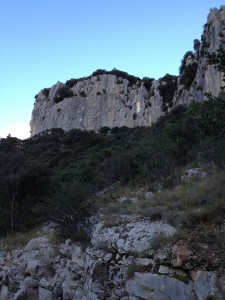At lab meeting back in October, they asked me if I knew what Via Ferrata was. I had never heard of it before. Turns out it’s from the Italian for “iron road.” Charlotte drew pictures on the white board to show how it’s done: hiking in the mountains attached to a steel cable. That seemed fine to me – I like hiking, I like mountains, I like a nice view, and being attached to a steel cable sounded like a good safety measure. Much better than, say, rock climbing. That’s for crazy people.
Then Charlotte asked me if I had vertigo. Oh no, I said, I don’t have vertigo.
I think of vertigo as an irrational, paralyzing fear of heights.
Actually, I think of vertigo as having more to do with dizziness and nausea, but the French seem to use it to mean fear of heights.
In any case, this seems to me quite a different thing having a completely rational fear of falling from great heights and dying horribly on the rocks below.
Which, as it turns out, I have in abundance.
After several months of waiting for a day when everyone could go and it wasn’t raining, we finally embarked on our Via Ferrata outing. It was a lovely sunny day in early February. We drove north of Montpellier to the Via Ferrata du Thaurac, near the village of Ganges. We parked at base of a cliff along the gorges of the Herault River, the namesake of the Department where Montpellier is located.
(The name Herault is pronounced something like “Aygghho.” Just like it’s written, as far as the French are concerned.)
We each got a harness and a helmet. My helmet was a standard bicycle helmet. The harness was something you stepped into, with belts around your thighs and waist, a double rope with with carabiners at the end attached firmly to a loop at the front of the waist belt. This all seemed pretty reassuring.
Then we hiked up from the road onto a steep gravelly trail. This didn’t seem so bad. Then we got to a cave. Nice and cool and dark inside. Bats could be heard squeaking quietly deep in the cave. Michel, who studied the evolution of disease resistance in mosquitoes before turning his attention to human evolution, said that there were also female mosquitoes hibernating in the caves. They had gotten sperm from male mosquitoes in the fall. The males were long dead now. The females kept the sperm in storage, waiting for the weather to get warm enough form them to fertilize and lay their eggs and start a new generation of bloodsuckers.
Michel explained the basics of Via Ferrata: you attach both your carabiners to the cable. When you get to the end of the cable, unfasten one and attach it to the next cable before you unfasten your second carabiner. That way you are always attached to at least one cable with at least one carabiner. And wait for the person in front of you to move to the next cable before you attach, so that there is no more than one person per cable – so you don’t both fall and have your combined weight rip the supports out of the rock. That seemed easy enough. I had done a high ropes course with my son’s grade school class, so this all seemed familiar and doable.
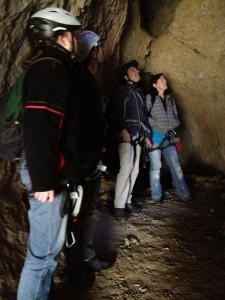 The first person in line fastened his carabiners to the cable running up the cave wall and began climbing up a series of steel rungs: u-shaped lengths of rebar hammered into the wall and secured with what looked like epoxy. He went up. Straight up. He crossed a gap above our heads, using rungs that seemed uncomfortably far apart. Soon he disappeared, going up a chimney towards the light at the top. One after another, the rest of the lab members followed, calmly climbing up into the abyss. (What’s the opposite of an abyss? Whatever that is.)
The first person in line fastened his carabiners to the cable running up the cave wall and began climbing up a series of steel rungs: u-shaped lengths of rebar hammered into the wall and secured with what looked like epoxy. He went up. Straight up. He crossed a gap above our heads, using rungs that seemed uncomfortably far apart. Soon he disappeared, going up a chimney towards the light at the top. One after another, the rest of the lab members followed, calmly climbing up into the abyss. (What’s the opposite of an abyss? Whatever that is.)
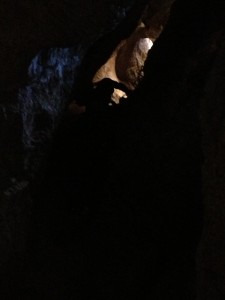
Then it was my turn. It took some time to get the hang of attaching and unfastening the carabiners, holding the rope to keep them close in hand. Michel followed along behind, providing helpful advice, patiently waiting for me to slowly crawl up and out of the cave.
It was terrifying. Completely terrifying. And exhausting. And it just got worse and worse. Climbing straight up inside the cave was sort of okay, because there were cave walls on all sides. But climbing up out of the cave into the open air revealed just how far we were above the river valley below.
It was a long way down.
I knew that as long as I kept attached to the cables, I probably wouldn’t die. However, it also seemed clear that if I did fall, I could get pretty banged up before coming to a halt. I imagined what it would be like to make the rest of the trip with a broken arm or leg. Which wouldn’t be fun.
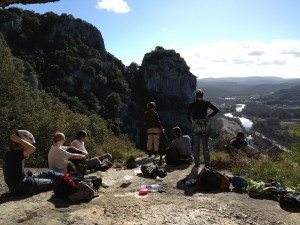
But soon enough we were up and out. We stopped for lunch at a cave with great view of the wooded river valley. It was easy to imagine being here in the Paleolithic, when mammoths and cave bears wandered the valley. Prehistoric people used many of the caves in this area, and probably stopped at this very site to enjoy the same view. I thought of the Shamudoi, a tribe in Jean Auel’s Earth’s Children series who lived in mountain caves above the Danube River.
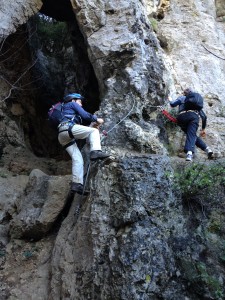
After lunch, we walked along a gentle path through the woods, which was pleasant enough, until we got to an even more terrifying series of climbs. Inside one cave, a sign pointed to a “Pont de singe,” a monkey bridge, which was a pair of steel cables crossing an open chasm high above our heads. You fastened your carabiners to the high cable and stepped out onto the lower cable. This actually wasn’t as bad as it seemed, because holding on to the upper cable was nice and secure.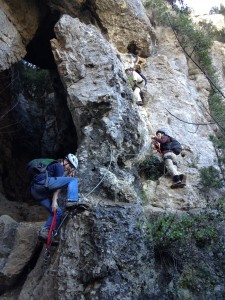
We climbed higher and higher, and eventually found ourselves clinging to a cliff face high above the road where we had parked.
From time to time, visiting parks like Yosemite, I have looked up to cliff faces and seen the rock climbers and thought, “Those people are crazy. I have no desire to do that.” Now I was one of those people.
For much of the last stretch I climbed behind Julien, who had come up with the idea of doing the Via Ferrata in the first place. He loves to climb. He grew up in the mountains. He was having fun.
“This next stretch is easy,” he promised.
And it was easy, in that it involved moving horizontally rather than climbing. But psychologically it was completely terrifying.
I think of myself as reasonably fit, but it took a lot of strength to hold on and climb, and I was soon pretty weary. Being terrified probably didn’t help.
Fear of heights has become a classic example of an evolved psychological mechanism – one of the “modules” that evolutionary psychologists talk about. In a world with substantial gravity, it makes tremendous sense for heavy-bodied, wingless creatures like ourselves to be afraid of edges and heights.
For much of the 20th Century, associative learning theory dominated psychology. In this view, humans have no instincts, apart from a general-purpose associative learning instinct. Fear of heights is something we learn from bad experiences, such as falling from great heights. Starting in the 1990s, though, several studies looking in more detail at fear of heights found that prior experience didn’t explain the extent to which people experienced fear when exposed to heights. Studies also found that crawling infants and young animals of other species avoided moving across transparent surfaces that were completely safe but looked scary.
You don’t need to have fallen off of a cliff to find cliffs terrifying. Like many adaptive emotional responses, we may be unaware of fear of heights until we need it. Just thinking about the trip beforehand, I had no idea of the intensity of the fear that I would feel. This is similar to other evolutionarily important emotional responses, such as sexual desire, romantic love, jealousy, parental love, and grief. We experience these powerful emotions at key points in our lives, and they help guide us towards actions that, on average, make it more likely for us to propagate our genes. Unfortunately, while the passions may have evolved to promote behaviors that, on average, over evolutionary time, provide fitness benefits, they are often unreliable guides to behavior in specific cases, and they can sometimes prove paralyzing rather than helpful, or lead us to commit actions that we later regret.
Among the passions that have been proposed to be psychological mechanisms are those relating to violence and warfare: patriotism, xenophobia, hatred, revenge.
In a 1999 review of Michael Ghiglieri’s book Dark Side of Man, geneticist Richard Lewontin expressed doubt that aggressive behavior in humans is the result of psychological adaptations, based on his own experience of never having had such urges:
“Human males are described as being by nature rapists, murderers, warriors and perpetrators of genocide, one chapter for each. I begin to doubt my own species identity, having never engaged in, or fantasized about, any of these activities whether drunk or sober, asleep or awake. “
What if, however, the passions motivating violent behavior are like fear of heights: dormant until set off by a highly specific set of cues? Most of the time, I do not experience fear of heights, because most of the time I am not clinging to the edge of a cliff hundreds of feet above the ground. But when my brain detects the unusual set of cues associated with the ground being ridiculously far away, it sets off a whole series of powerful physiological and psychological reactions. Perhaps the passions that motivate people to do horrible things during wartime are like this: quiescent within each of us, never noticed unless wakened by a set of circumstances that in modern, peaceful, prosperous democracies, most of us are fortunate enough to never experience.
As far as I know, we don’t really know much about the details of the purported wariness of heights module. As with much of evolutionary psychology, we’re still very much in the black box phase of science: there is this black box that we call the “wariness of heights module,” that helps to keep us alive by making us avoid falling off edges. Exactly how it is represented in the brain, and how it develops, and how it relates to genes, remains unknown. We have a lot left to learn about the brain. But to me, it seems a vast improvement to be looking at the brain as a product of evolution, designed by natural selection to solve evolutionarily important problems, than to see it as an undifferentiated associative learning device.
Some people dislike evolutionary explanations for behavior because they think such explanations require that human behavior consist of inflexible responses triggered by simple stimuli. However, fear of heights seems to be a good example of a psychological response that is both powerful, and capable of being modified by personal experience. For example, during the course of the afternoon, my fear gradually subsided. I managed to calm down, move slowly and deliberately, without looking down or visualizing too vividly my widowed wife and orphaned children.
As with many adaptations, there also seems to be variation, both among individuals, and perhaps among populations as well.
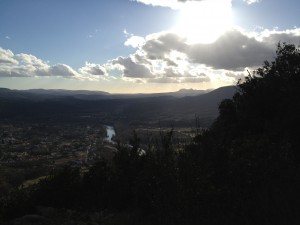
Julien, raised in the mountains, seemed perfectly happy standing on the edge of the cliff, looking out at the spectacular view. I grew up in flat country. Even though I have ended up spending a fair amount of my adult life following primates on cliffs and mountains, I was still much happier clinging to the rock face ten feet back from the edge.
As for populations, about 10% of New York steelworkers are Mohawk Indians, and some people have suggested that people from this tribe naturally have no fear of heights.
According to this article, ironworker Kaniehtakeron ‘Geggs’ Martin says, “They always often ask me if I’m afraid of heights… a lot of people are. I’m one of them who isn’t.”
Another possibility is that these Mohawk steelworkers feel the fear, but because their culture emphases courage and risk taking, they don’t show fear. For example, according to this article, “Anthropologist Morris Frielich . . . compares high-steel Mohawks to warriors who risked death and returned with booty. Some anthropologists have also suggested that the risky work gave tribesmen a chance to test and display their courage.”
At one point near the end of the Via Ferrata, I thought I wouldn’t be able to make it any further. We had just crossed another monkey bridge across a chasm. To the left, down a gentle horizontal trail, someone was playing guitar and singing. Julien said I could take that trail and go out the easy way. Julien climbed up, but said there was only about 5 m of really hard stuff. I tried going up. About ten feet off the ground, the rock face bulged out, and it was there that you had to change carabiners to the next cable. I was tired, I couldn’t reach the next rung, and couldn’t get high enough to change cables comfortably. I climbed back down to rest and reconsider. Several other people went ahead of me.
Charlotte went on ahead, and hanging from the rock, called down to me, “Imagine that you have to save a beautiful princess!”
I gave it another try and made it up and over the bulge, and finally up over the top.
Which now has me puzzling over another evolutionary problem:
The appeal of putting ourselves in risky situations. Why do people willingly do such things? And why would they ever do it a second time?
And yet another evolutionary puzzle:
Looking back, I’m starting to think it would be fun to try again.
